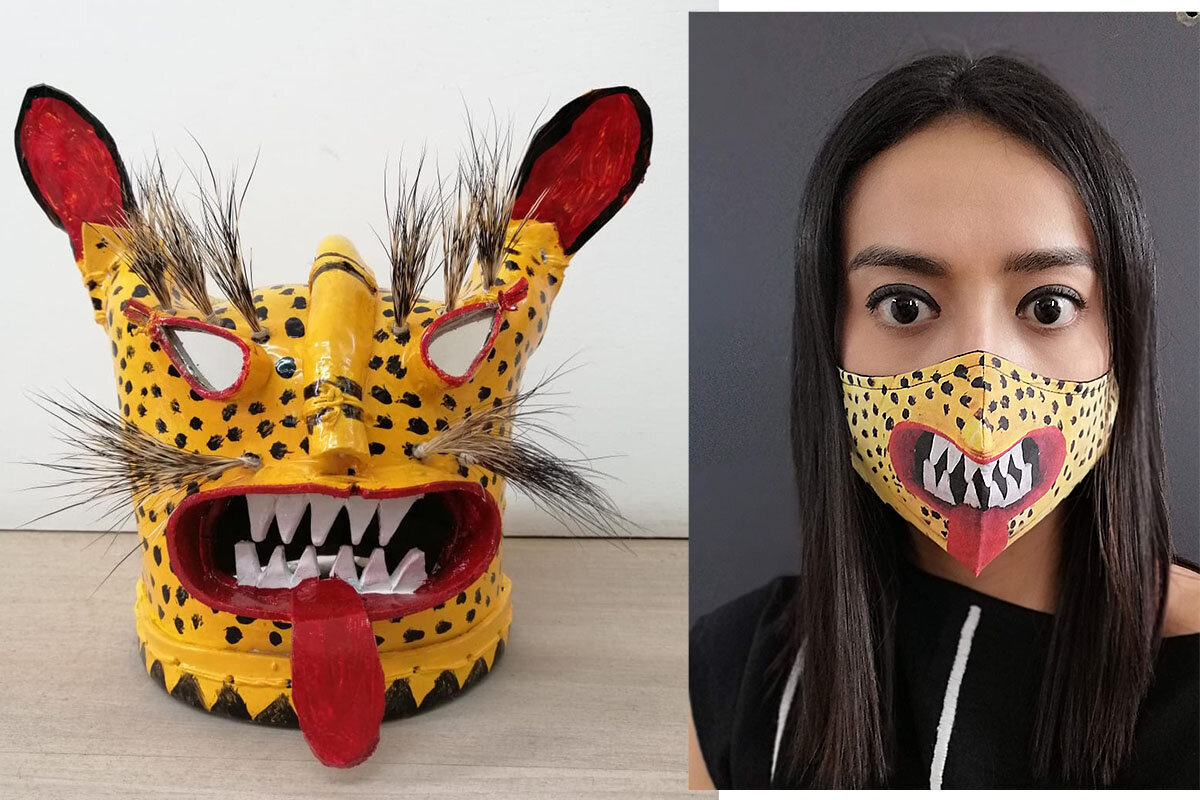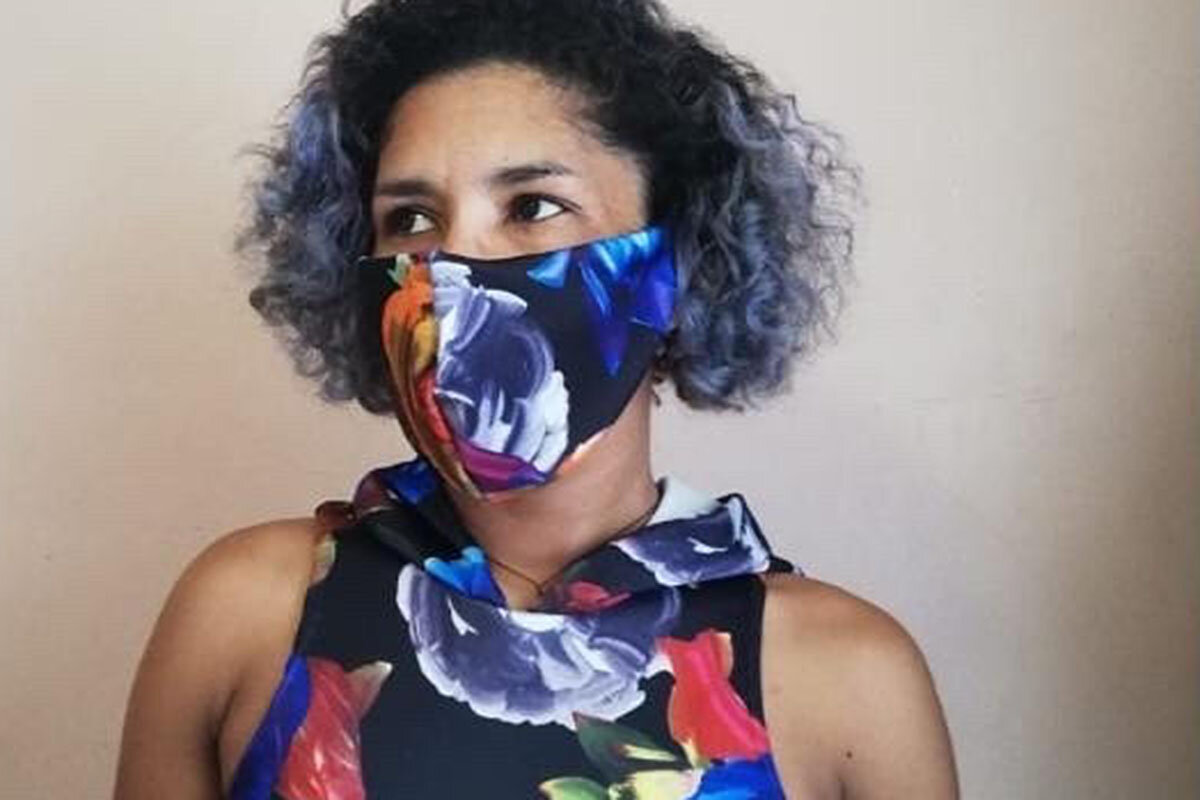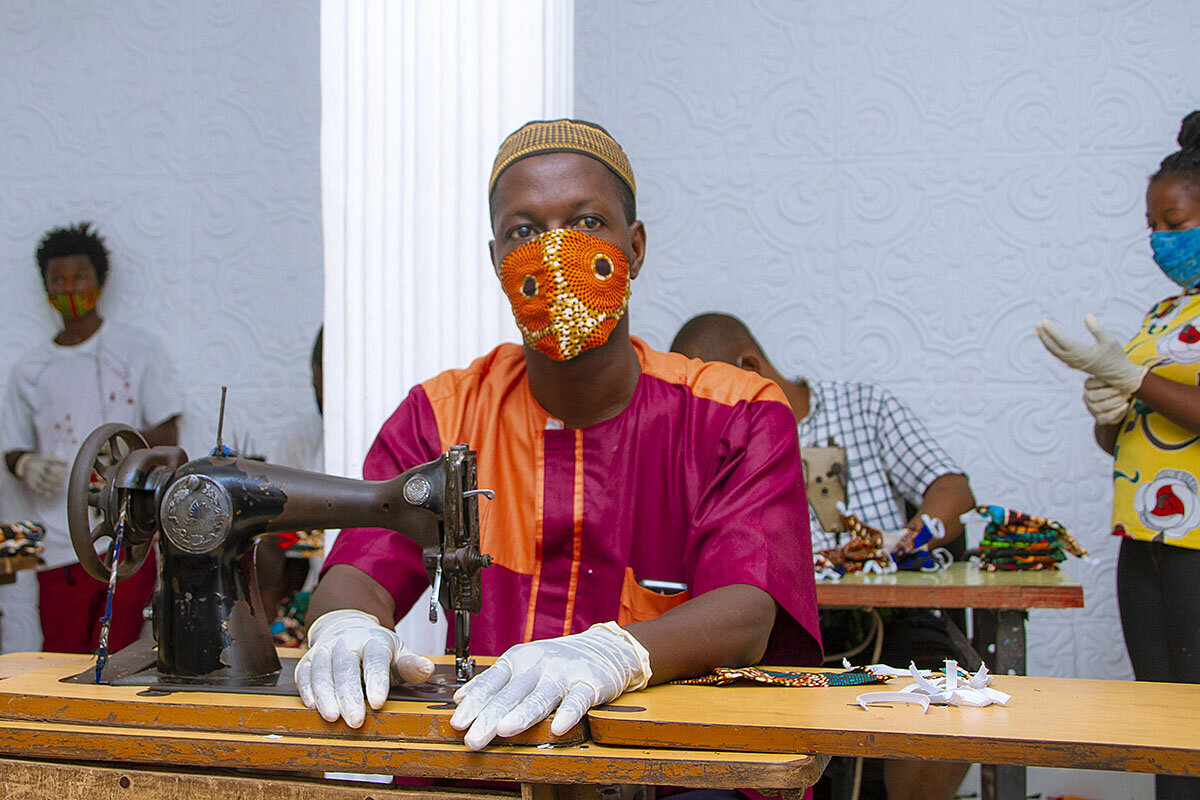Face masks unleash creativity: ‘You can be part of the bigger story’
Loading...
| Basel, Switzerland; Mexico City; and Johannesburg
Pink flamingo masks in Florida. Lucha libre wrestler masks in Mexico City. Futuristic masks on Parisian catwalks and bold prints splashed across Sierra Leonean markets.
Three months ago, in much of the world, face masks were a no-nonsense medical tool. But today, as the pandemic drags on, they’ve become a de rigueur part of daily attire – from DIY superhero masks for kids to House Speaker Nancy Pelosi’s pantsuit-coordinated silks. As more public health officials have recommended face coverings, shortages in vital protective gear have turned ordinary citizens, fashion designers, and luxury brands into lifesaving mask-makers.
At times, it’s a political act. At times, a gesture of generosity. And increasingly, a fashion statement. COVID-19 has wrought chaos, but also unleashed an international wave of creativity and solidarity. Mask designs vary, but the underlying ethos is the same: This pandemic is ugly, but we can respond with beauty.
Why We Wrote This
When life gives you lemons, make lemonade. And when you need to wear a face mask – well, why not make it a beautiful one? Resourceful artists are adapting their businesses to produce, and often donate, 2020’s must have.
Editor’s note: As a public service, all our coronavirus coverage is free. No paywall.
“By wearing a mask you’re indicating that you care about the people around you,” says Valerie Steele, director of The Museum at the Fashion Institute of Technology in New York. “It is so easy to include a mask with your ensemble.”
Luxe look
The meaning and look of masks depends largely on where you come from. Western culture is not keen on masks – sometimes associated with thieves, or even beak-like bubonic plague doctor attire – and many European countries ban face coverings.
“Choosing a fashionable mask, color-coordinating it with your outfit, is taking that extra step towards making it seem friendly,” says Dr. Steele. She predicts masks will remain in the Western wardrobe post-pandemic, but less so than in Asia, where they have been common for years to protect against colds and pollution.
Major luxury brands in Europe played good Samaritan during the worst of the crisis, making face masks for health workers and linking mask purchases to charitable donations. Many remain hesitant to chase profits, but other retailers are charging ahead.
French designer Marine Serre proved prescient, featuring masks in her collections since 2019. One even included a high-end air filter. “Fashion is just a translation of what is happening around us,” says Ms. Serre, who found inspiration biking in polluted Paris.
Now, her priority is to make masks that are safe, not just fashionable. “The pandemic has broken an ice wall,” she says. “We can wear masks and it is fine and we can also have fun. Let’s see how the mask evolves with our lives.”
The Czech Republic was one of the first European nations to make masks mandatory, sparking a sewing frenzy. A Facebook group called “Czechia sews face masks” gathered a following of more than 40,000 people, mainly women willing to make free masks for health workers. In some areas, sewers hung up their creations on “mask trees” outside, where anyone in need could take them.
An exhibit at the National Museum in Prague showcased this outburst of solidarity. “People wanted to wear something that is interesting, that is fashionable,” says curator Mira Burianova. Some masks are by local designers, but most are homemade creations quickly stitched together to confront the crisis.
“It is a symbol of this period, but I hope that our children will not need to wear masks,” she adds.
“A country of masks”
Masks in Mexico, meanwhile, reflect a history of creative resilience.
“Mexico is a country of masks,” says designer Carla Fernández. “We dance with masks; there’s lucha libre, carnivals, parties. Now we’re using them in different ways.”
The coronavirus pandemic snuffed festivals and tourism. But many are harnessing the nation’s vibrant culture to save jobs and keep each other safe. Out-of-work wrestlers make masks mimicking sparkly, lace-up ones worn in the ring. The designs of artisans who typically craft traditional wooden or leather masks, such as of animals or devils, are now printed on fabric.
Ms. Fernández worried COVID-19 would hit the nearly 60% of Mexicans in the informal economy especially hard. She teamed up with a beverage company to produce 50,000 masks donated to public transportation workers and medical professionals. More are for sale to the public. The pivot helped keep afloat the 175 artisans and 20 employees she regularly works with, and 25% of all sales go back to the traditional mask-makers whose images are being used.
Even for Ms. Fernández, a well-established designer, finding appropriate fabric and functional patterns was a challenge. But the results are masks covered in brilliant images, like the sharp, triangular-toothed, bright-orange jaguar. She says Mexican adaptability – dating back to indigenous practices mixing with Spanish culture – is evident in how citizens reacted.
“There’s always someone to give you a hand,” says Ms. Fernández, and it’s typically not the government. “Family, friends, and community are a pillar of society. It’s in our blood: If you see a problem, you help.”
Jesús Ortiz shares that instinct. The father of three went to the United States when he was 19 and was deported almost 10 years later, separating him from his family. Lately, he’s spent his Fridays traveling across Mexico City, delivering face masks made by fellow deportees and returnees. “It keeps me busy and it’s a way to help fewer people get exposed,” he says. It also helps counter stereotypes that deportees are criminals or victims.
“It’s really important for deportee and returnee communities to mobilize together because they often don’t have those family safety nets that many Mexicans – and even Mexican public policy – rely on to respond to crises,” says Jill Anderson, co-director of Otros Dreams en Acción (ODA), an organization Mr. Ortiz belongs to, which supports deportees and returnees. Three members make masks covered in cactuses to donate or to sell.
Experts credit a past pandemic in Mexico for its openness to face masks. In 2009, when the H1N1 “swine flu” emerged here, masks were the central measure pushed by the government, not stay-at-home orders, notes urban anthropologist José Ignacio Lanzagorta.
“We’ve assimilated to the use ... little by little,” he says.
Covered, and beautiful
Many African countries, meanwhile, have already made face covers compulsory. And the continent’s designers have responded with masks designed to turn a drab public health protocol into something beautiful.
“I thought, we can find a delicious way to be safe and fashionable at the same time,” says Cape Town designer Tracy Gore, who introduced masks to match her flower print tops and bomber jackets when masks became mandatory in South Africa.
Mask-wearing took root fairly easily across many parts of Africa, thanks in part to a culture of made-to-order fashion, facilitating companies’ pivot toward the latest health accessory.
In Freetown, the capital of Sierra Leone, thousands of tailors usually work from tiny studios tucked between barber shops and corner stores, or in clattering rows in the fabric section of markets. When the government began restricting movement and enforcing social distancing measures, customers disappeared. No one needed a new dress for church or a birthday or a wedding.
But Mary Ann KaiKai, who runs a label called Madam Wokie, found purpose and opportunity. Ms. KaiKai had noticed how most of the thousands of women who sold fish, plantains, and neon orange bottles of palm oil in overcrowded markets didn’t wear masks. She rustled up donations, hired 100 out-of-work tailors, and turned her three-story atelier into a mask-making assembly line. Within three weeks, her team had made and distributed 72,000 masks across Freetown.
“Our question was, how do you make something that addresses this need but also is something where people will say, ‘This is colorful, this is vibrant, and I want to keep wearing this because it’s beautiful,’” says Ms. KaiKai, who made luxury clothes before the crisis. The masks she designed are made from ankara, a printed fabric known for its swipes of bright colors and angular geometric patterns.
“Especially with the health system in Sierra Leone being weak, it’s important to protect yourself before you get sick,” she says. “I’m not going to win any fashion awards producing masks. But it’s about how you can be part of the bigger story of defeating this disease.”
Editor’s note: As a public service, all our coronavirus coverage is free. No paywall.









